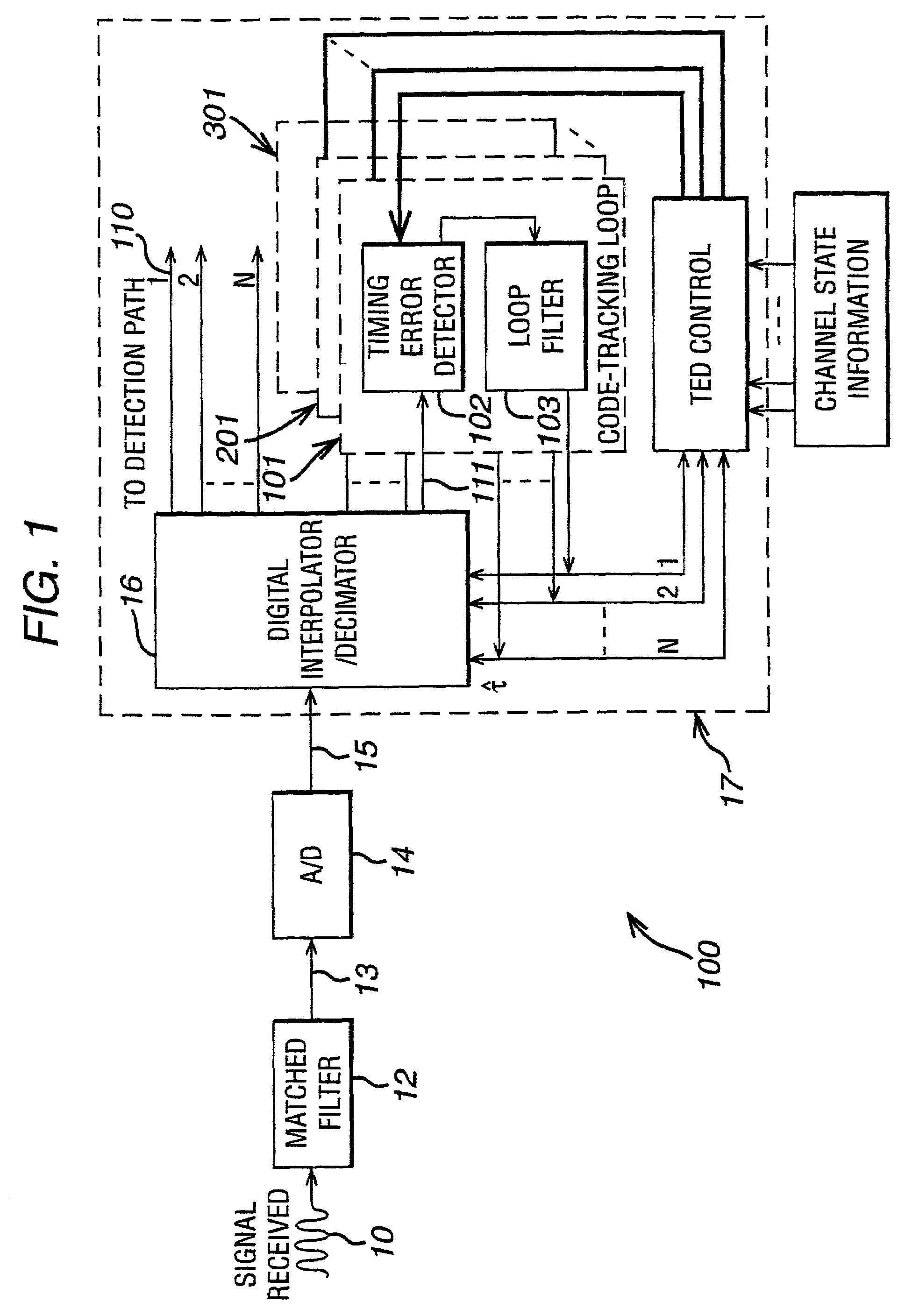[0006]However, in a
wireless communication
system a transmitted signal may still propagate along different paths due to reflection or scattering. Therefore, the signal is received as a superposition of different signal components each propagated along one of the possible paths. As reflected signals will be differently delayed according to their paths compared to each other and compared to the direct signal, each of the signal components of one specific path is interfered by a plurality of other time- and phase-shifted signal components of other paths. If there is no direct
sight between the
transmitter and the receiver the connection can still be provided by the reflected or scattered signal components, but their interference generally causes disadvantageous effects to the connection performance. Phase-shifted signal components reduce the signal-to-
noise ratio of the direct or main signal component and cause power dissipation. Furthermore, the superposition of phase-shifted signals may cause destructive interference between different signal components. These disadvantageous effects reduce the reliability and stability of the
decorrelation in the receiver, e.g. increase the
bit error rate. Especially when one of the communication partners, e.g. a mobile terminal or phone, is moving these multipath phase shift and interference may change quickly causing a fast fading effect.
[0007]To reduce interference of
phase shifted signal components several algorithms have been proposed in the past for tracking of the multipath delays. All of them suffer from either high sensitivity to multipath fading and thus reduced performance in such environments, or implementation complexity which is prohibitive for the use in mobile terminals, where size, production cost and
power consumption are critical issues. One example for code-tracking is the so-called early-late gate
timing error detector (EL-TED), being a natural solution to a mathematical optimisation problem for nondispersive,
additive white gaussian noise channels (AWGN). For a detailed description of prior art see Heinrich Meyr, Marc Moeneclaey and Stefan Fechtel, Digital Communication Receivers: Synchronization, Channel
Estimation and
Signal Processing, John Wiley and Sons, New York, 1998, Heinrich Meyr and
Gerd Ascheid, Synchronization in Digital Communications. Vol. 1, John Wiley & Sons, New York, 1990 and A. J. Viterbi, CDMA—Principles of
Spread Spectrum Communication, Addison-Wesley Publishing Company, Reading (
Mass.), 1995.
[0008]The EL-TED is able to track echo path delays, as long as the relative delay between two paths is larger than some threshold. If the relative delay is smaller than the threshold, the EL-TED can no longer distinguish the two paths. Furthermore, tracking of weaker paths (lower power) can be disturbed by stronger paths with a relative delay larger than the aforementioned threshold. For an example of an
algorithm with significantly higher implementation complexity than the EL-TED, see R. A. Iltis, An EKF-Based Joint Estimator for Interference, Multipath, and Code
Delay in a DS Spread-Spectrum
Receiver, IEEE Transactions on Communications, Vol. 42, No. 2 / 3 / 4, February–April 1994.
[0009]In indoor mobile communication scenarios, the
path delay of the last identifiable echo path is small compared to outdoor scenarios. All of the signal energy is dispersed around the path with the shortest delay and a sufficient echo path resolution is critical for adequate receiver performance, expressed for instance as the bit-error rate (BER). None of the existing EL-TED algorithms with reasonable complexity is able to track adjacent path delays which are separated by less than the mentioned threshold. With such a
tracking system, the required signal-to-
noise ratio to achieve a certain BER is reduced significantly.
[0010]A
system using
multipath interference cancellation in the code-
tracking loop was presented by Wern-Ho Sheen and Chien-Hsiang Tai, A Noncoherent
Tracking Loop With Diversity and
Multipath Interference Cancellation for Direct-Sequence Spread-Spectrum Systems, IEEE Transactions on Communications, Vol. 46, No. 11, November 1998. There, a group of rake fingers is tracked jointly. In each finger, respreading and recoding is performed after the normal rake correlation in order to yield signals which model the interference for each multipath. These interference terms can then be subtracted from the incoming signal in order to improve the tracking performance, inherently by allowing a finger assignment where adjacent fingers are placed around one
chip duration apart. This scheme suffers from high implementation complexity, expressed by the respreading and recoding necessary in each finger.SUMMARY OF THE INVENTION
[0011]Therefore, it is an object of the present invention to provide a method and / or a rake receiver for code-tracking in
CDMA communication systems of
low complexity and cost.
 Login to View More
Login to View More  Login to View More
Login to View More 


